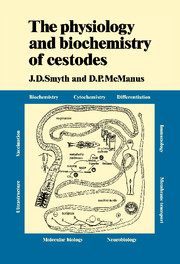Book contents
- Frontmatter
- Contents
- Preface
- Acknowledgements
- 1 The cestodes: general considerations
- 2 The adult cestode: special structural features relevant to its physiology
- 3 The adult cestode in its environment
- 4 The adult: general metabolism and chemical composition; lipid metabolism
- 5 The adult: carbohydrate metabolism
- 6 The adult: proteins and nucleic acids
- 7 The biology of the egg
- 8 Developmental biology of larvae
- 9 Development within definitive host
- 10 Cultivation of cestodes in vitro
- 11 Immunobiology of cestodes
- References
- Index
10 - Cultivation of cestodes in vitro
Published online by Cambridge University Press: 24 November 2009
- Frontmatter
- Contents
- Preface
- Acknowledgements
- 1 The cestodes: general considerations
- 2 The adult cestode: special structural features relevant to its physiology
- 3 The adult cestode in its environment
- 4 The adult: general metabolism and chemical composition; lipid metabolism
- 5 The adult: carbohydrate metabolism
- 6 The adult: proteins and nucleic acids
- 7 The biology of the egg
- 8 Developmental biology of larvae
- 9 Development within definitive host
- 10 Cultivation of cestodes in vitro
- 11 Immunobiology of cestodes
- References
- Index
Summary
General considerations
A major development in parasitology within recent years has been the increased interest in attempts to culture parasites outside their hosts. A stimulus to this has been the introduction of efficient antibiotics and the general availability of commercially prepared media – both problems which greatly discouraged most early workers from working in this area. Substantial progress in this field has been made and a number of species can now be cultured to maturity or near maturity and several species (e.g. Hymenolepis diminuta) have been cultured through their entire life cycle in vitro. Early work in this field has been reviewed elsewhere (796,800, 905). More recent work has been reviewed by Arme (24), Evans (198) and Howell (339).
It is well recognised that the value of in vitro techniques is that not only do they allow experiments to be carried out without the use of laboratory animals (which is desirable in itself) but also they allow the nutrition, physiology and biochemistry of a parasite to be studied in isolation from the interacting physiology of its host. Such techniques are also of especial value in studying immunity of cestodes, for they allow the collection of excretory/secretory (E/S) antigens to be undertaken without the problem of contamination by host molecules and this has greatly facilitated research in the development of possible vaccines. It is intended here to discuss only the general problems underlying in vitro culture and to deal with those species which have been cultured most successfully.
- Type
- Chapter
- Information
- The Physiology and Biochemistry of Cestodes , pp. 257 - 282Publisher: Cambridge University PressPrint publication year: 1989



